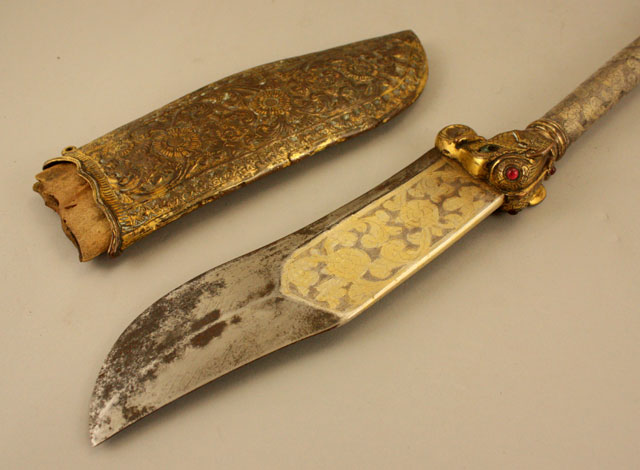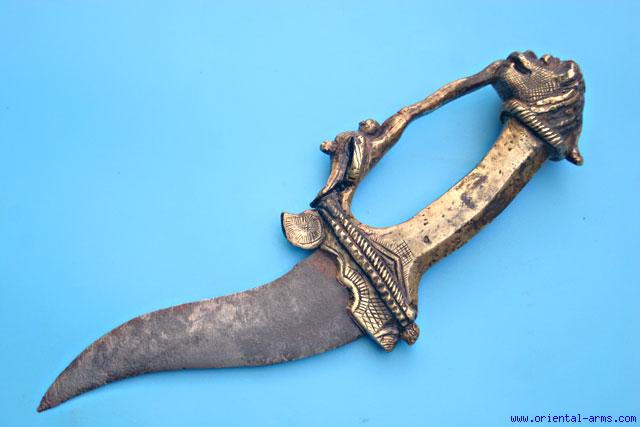Bhopa,
Itinerant narrator performers of the painted scrolls of Rajasthan, sometimes accredited with shamanistic powers.
Itinerant narrator performers of the painted scrolls of Rajasthan, sometimes accredited with shamanistic powers.
Bhorat,
The filler stitch, which unlike satin stitch is heavy on the surface and very light on the reverse, Kutch, Gujarat.
The filler stitch, which unlike satin stitch is heavy on the surface and very light on the reverse, Kutch, Gujarat.
Bhuj / katti,
The bhuj or katti, as its name implies, is the well known dagger from the city of Bhuj in Kutch, Gujarat but it was also popular in Sind as well as north India. The bhuj is a dagger with a unique shape. The blade is about 4 centimetres wide and about 20 centimetres long, with an S-shaped edge. The grip is of steel, circular in section and is about 50 centimetres long, i.e. it is more than twice as long as the blade. At the base of the blade is a stylised elephant head and for this reason it is sometimes called an ‘elephant dagger’. Due to its axed like shape the weapon is sometimes also referred to as an axe knife. The bhuj is, in fact, a combination weapon which can be used for thrusting and piercing as well as for slashing and cutting; its log grip is also suitable for two handed use.
The bhuj or katti, as its name implies, is the well known dagger from the city of Bhuj in Kutch, Gujarat but it was also popular in Sind as well as north India. The bhuj is a dagger with a unique shape. The blade is about 4 centimetres wide and about 20 centimetres long, with an S-shaped edge. The grip is of steel, circular in section and is about 50 centimetres long, i.e. it is more than twice as long as the blade. At the base of the blade is a stylised elephant head and for this reason it is sometimes called an ‘elephant dagger’. Due to its axed like shape the weapon is sometimes also referred to as an axe knife. The bhuj is, in fact, a combination weapon which can be used for thrusting and piercing as well as for slashing and cutting; its log grip is also suitable for two handed use.
Bhutasthana,
Shrine of bhuta deities of coastal Karnataka, usually near a peepal (ficus religiosa) or banyan tree.
Shrine of bhuta deities of coastal Karnataka, usually near a peepal (ficus religiosa) or banyan tree.
Bichwa,
The bichwa literally means a scorpion. This dagger was originally a Maratha weapon, and has a short, two edged, double curved blade. The hilt, which is padded towards its knuckles, is formed as a loop in which the hand is placed.
The bichwa literally means a scorpion. This dagger was originally a Maratha weapon, and has a short, two edged, double curved blade. The hilt, which is padded towards its knuckles, is formed as a loop in which the hand is placed.
Bidri,
Inlay of gold and silver wire on the blackened surface of an alloy of zinc and copper named after Bidar, a town in Karnataka.
Inlay of gold and silver wire on the blackened surface of an alloy of zinc and copper named after Bidar, a town in Karnataka.
Bidri,
Bidri describes metalwork produced by a technique found only in India: objects are cast from an alloy in which zinc predominates but which may include small amounts of lead as well as copper and tin. The surface of the object is made smooth and a solution of copper sulphate darkens it temporarily for the next stage of engraving. The engraving tools cut the design into the metal, which is then lighter in colour than the darkened surface and enables the pattern to be seen more clearly.
The inlay of gold and/or silver wire on the blackened surface is called bidri after Bidar, a town of its patronage and production for nearly 300 years in the Deccan. The inlay process involves sketching the design onto the surface of the object using a kalam or a needle-sharp implement and then engraving and chasing the design with a cheelne-ki-kalam or chisel. This is followed by the chappat-kalam or the blunt-edged chisel for precisely embedding the fine silver or gold wires, previously drawn from a taar-patti having holes of varying diameters, onto the surface. This technique is also called tarkashi.
Bidri describes metalwork produced by a technique found only in India: objects are cast from an alloy in which zinc predominates but which may include small amounts of lead as well as copper and tin. The surface of the object is made smooth and a solution of copper sulphate darkens it temporarily for the next stage of engraving. The engraving tools cut the design into the metal, which is then lighter in colour than the darkened surface and enables the pattern to be seen more clearly.
The inlay of gold and/or silver wire on the blackened surface is called bidri after Bidar, a town of its patronage and production for nearly 300 years in the Deccan. The inlay process involves sketching the design onto the surface of the object using a kalam or a needle-sharp implement and then engraving and chasing the design with a cheelne-ki-kalam or chisel. This is followed by the chappat-kalam or the blunt-edged chisel for precisely embedding the fine silver or gold wires, previously drawn from a taar-patti having holes of varying diameters, onto the surface. This technique is also called tarkashi.
Bind off,
To finish the final row of stitching in your work, bind off by knitting two stitches, slipping the first over the second, and repeating until only the last stitch is left. Then, cut the yarn and loop it through that final stitch.
To finish the final row of stitching in your work, bind off by knitting two stitches, slipping the first over the second, and repeating until only the last stitch is left. Then, cut the yarn and loop it through that final stitch.
Binding,
The operations involved in attaching together various parts of a structure using a secondary material. Binding is often used to refer to book binding. Bookbinding is the process of assembling and attaching together parts of a book. Bookbinding is said to have originated in India; Sutras were written on treated palm leaves, these were collated and placed between wooden boards and twine was threaded through them.
The operations involved in attaching together various parts of a structure using a secondary material. Binding is often used to refer to book binding. Bookbinding is the process of assembling and attaching together parts of a book. Bookbinding is said to have originated in India; Sutras were written on treated palm leaves, these were collated and placed between wooden boards and twine was threaded through them.
Binding thread,
The resist fibre (often strips of palm-leaf) tied in patterns around the warp or weft threads. This prevents dye from entering those sections of the threads. After the dye process, the resist bindings are removed before the patterned threads are woven.
The resist fibre (often strips of palm-leaf) tied in patterns around the warp or weft threads. This prevents dye from entering those sections of the threads. After the dye process, the resist bindings are removed before the patterned threads are woven.
Biological Diversity,
Article 2 of the Convention on Biological Diversity (1992) defines the term “biological diversity,” often shortened to “biodiversity,” as meaning the “variability among living organisms from all sources including, inter alia, terrestrial, marine and other aquatic ecosystems and the ecological complexes of which they are part; this includes diversity within species, between species and of ecosystems.”
Article 2 of the Convention on Biological Diversity (1992) defines the term “biological diversity,” often shortened to “biodiversity,” as meaning the “variability among living organisms from all sources including, inter alia, terrestrial, marine and other aquatic ecosystems and the ecological complexes of which they are part; this includes diversity within species, between species and of ecosystems.”

